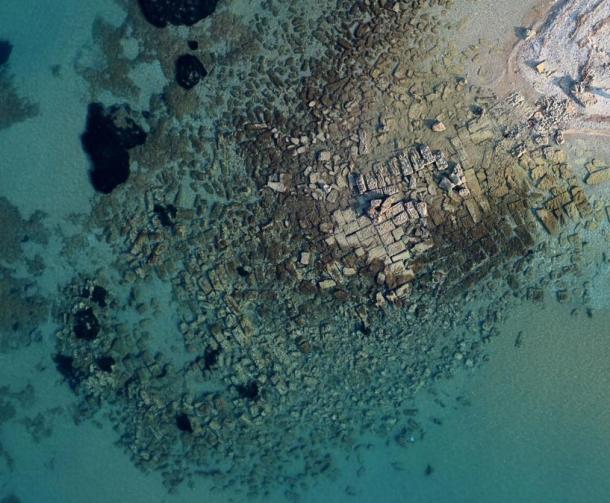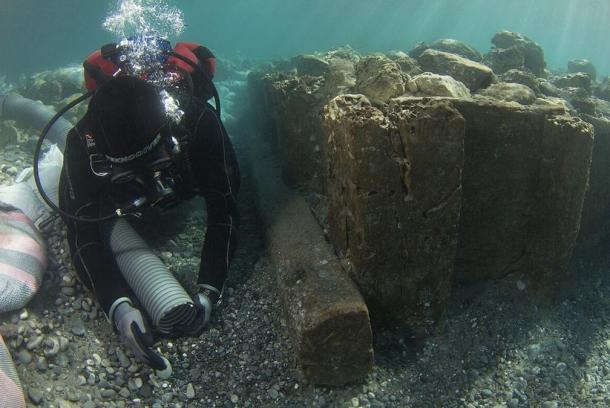Ancients - Underwater Ruins of Greek Harbor Are Full of Surprises
Researchers have made some surprising discoveries while investigating the underwater ruins of Lechaion, ancient Corinth’s partially submerged harbor town.
Lechaion was one of two bustling ports of the ancient city of Corinth. The harbor saw vibrant maritime activity for more than a thousand years, from the 6th century BCE to the 6th century CE. Ships and fleets departed filled with cargoes, colonists, and marines destined for ports all over the Mediterranean and beyond.

Aerial photo of the Western Mole (Credit: K. Xenikakis & S. Gesafidis).
“According to ancient sources, most of the city’s wealth derived from the maritime trade that passed through her two harbors, eventually earning her the nickname ‘Wealthy Corinth’,” says archaeologist Bjørn Lovén from the University of Copenhagen and co-director of the Lechaion Harbor Project (LHP).
The Lechaion Harbour Project (LHP), a collaboration between the Ephorate of Underwater Antiquities in Greece, the University of Copenhagen, and the Danish Institute at Athens, is exploring the submerged main harbor of ancient Corinth.
The research team has initiated full-scale excavations and a digital and geophysical survey of the seaward side of the harbor using various innovative technologies, including a newly developed 3D parametric sub-bottom profiler. To date they have uncovered two monumental moles constructed of ashlar blocks, along with a smaller mole, two areas of wooden caissons, a breakwater, and an entrance canal that leads into Lechaion’s three inner harbor basins.
The 2015 excavations focused on two areas. The first is a unique, early Byzantine mole constructed of six well-preserved wooden caissons together stretching 57 meters in length. The second is the stone-lined entrance canal to the little-explored Inner Harbor of Lechaion.
“We have found and documented several monumental architectural structures, built at great expense, showing that Lechaion was developed as a grand harbor to match the importance of her powerful metropolis, Corinth,” says Lovén.
Surprise Discovery
The discovery of well-preserved wooden caissons, however, caught everyone off guard. The wooden caissons acted as single-mission barges, built for the express purpose of being sunk together with their concrete cargoes, all of which were designed to form a solid foundation to hold back the force of the sea along this highly exposed stretch of coast.
Roman imperial engineers employed a similar technology on a large scale at Caesarea Maritima in Israel in the late first century BCE, but these are the first of their kind ever discovered in Greece with their wooden elements still preserved.
A preliminary C-14 carbon date places the caissons in the time frame of the Leonidas Basilica, the largest Christian church of its time. Construction of the basilica began in the middle of the 5th century CE. It was 180 meters (591 feet) long—about the same size as the first building phase of St. Peter’s Basilica in Rome. Scholars generally assume that harbor facilities in the Mediterranean were built in the Greek and Roman period, then simply repaired and maintained during the Byzantine period. The discovery of the mole constructed of wooden caissons challenges this picture.
The mole is a rare example of major harbor construction in this later era, but it may be indicative of a larger pattern of more ambitious harbor construction in this period, such as the Theodosian harbor (modern Yenikapi) at Constantinople, which has recently been excavated.
Researchers wonder if it is possible that the construction of this immense edifice coincided with renewed buildup of the harbor, thereby facilitating the arrivals and departures of visitors and pilgrims. At all events, the benefit of these innovations was short-lived, as Lechaion and its basilica were destroyed by a massive earthquake in the late 6th or early 7th century CE.

Archaeologist documenting wooden caisson (V. Tsiairis)
Unexpected Scale
Vestiges of the ancient entrance canal have been exposed on the modern beach for years, so there has been little doubt of its location. The scale, however, was surprising. So far, the team has uncovered some 55 meters (180 feet) of its sides, which protected ships coming into and exiting the three inner harbors of the town.
And the team has also found evidence that the ancient harbor was likely located much farther to seaward, perhaps as far as 45 meters (148 feet) from the modern shore. A geophysical study is underway to understand how the site has evolved over time as a result of sea-level change and possible coastal subsidence.
Lovén says the project should offer a clearer picture of how this bustling harbor evolved over time and enabled the development of Corinth as a major economic and military power during the Greek, Roman, and Byzantine periods.

No comments:
Post a Comment